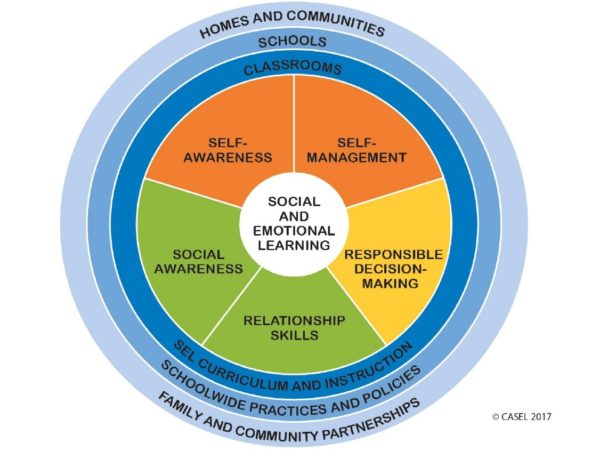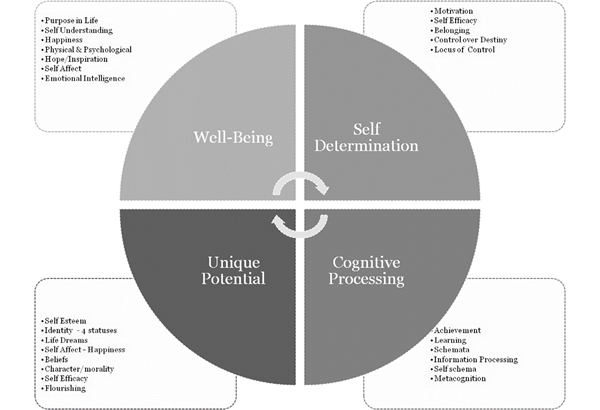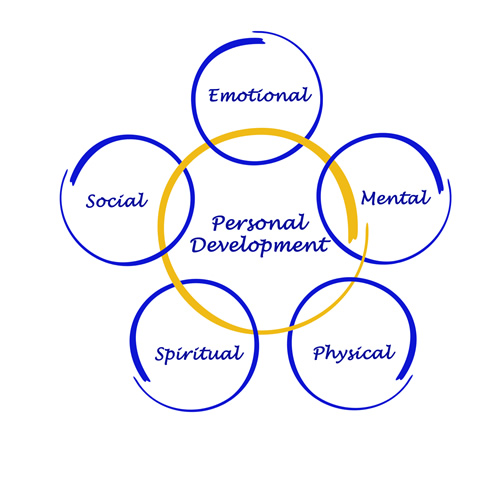We are often asked for the definition of social-emotional learning (SEL). One common and useful SEL definition is the process of learning to integrate thinking, feeling, and behaving in order to become aware of the self and of others, make responsible decisions, and manage behaviors.
2 SEL models
There are two SEL models or frameworks emerging as the consensus view.
1. CASEL
The Collaborative for Academic, Social, and Emotional Learning (CASEL) developed an SEL model that promotes the inter-relationships between classrooms, schools, families, and communities.

2. iSELF
The Integrated Self Model (iSelf) is an SEL model to teach understanding of the inner self and how the inner self interacts with others through cognitive and positive psychology attributes.

This figure depicts the four dimensions of the Integrated Self Model (iSelf) with positive psychology and cognitive psychology attributions. This model was first made available to practitioners and researchers in The Self in Schooling: How to Create Happy, Healthy, Flourishing Children in the 21st Century (2013).
iSELF helps SEL dive deeper into imparting emotional and psychological attributes to children through schooling and family activities in order to impact mental health and well-being. The iSelf model takes a research- and evidence-based approach to teaching young people how to know themselves and to change their brains from experiencing mental illness to mental health, with a new vision of self, others, and all.
Related: 11 tips on creating a positive school climate
Dr. Frederick Brown, Penn State emeritus professor of the psychology of well-being, wrote, “[The] iSelf model emerges from the interaction of current scientific information about the direct influence by emotions, both positive and negative, upon cognitive functioning. These emotions, in turn, are based upon personal relevancy and meaningfulness and are the controlling switch by which effective learning takes place or not. A positive emotional approach facilitates a sense of well-being that, in turn, enhances a willingness to learn.”
What does SEL best practices mean?
SEL best practices are different from models and require separate considerations. A best practice is a working method (or set of working methods) that is widely accepted as being effective in producing the attributes, skills, and competencies in the model. The model that is used makes a difference as to the potential outcomes.
A study conducted by the Harvard Graduate School of Education, with funding from the Wallace Foundation, demonstrates that educators are still in the process of defining SEL and establishing effective models and best practices: “The field of social and emotional learning (SEL) is rapidly expanding. In the past decade, SEL has emerged as an umbrella term for a number of concepts including non-cognitive development, character education, 21st century skills, and trauma-informed learning, among others.”
With SEL definitions still emerging, we believe that educators need to focus their energies on the mental health and well-being needs of their students, and to achieving these outcomes through a comprehensive set of self-attributes.
Related: Teacher training does wonders for students’ emotional regulation
Examples of SEL best practices
The following examples are of SEL programs that align best practices with meaningful models:
- Responsive Classroom– According to CASEL, this is one of the most well-designed, evidence-based SEL programs. The Responsive Classroom approach to teaching is comprised of a set of well-designed practices intended to create safe, joyful, and engaging classroom and school communities. The emphasis is on helping students develop their academic, social, and emotional skills in a learning environment that is developmentally responsive to their strengths and needs.
- Self Across the Curriculum (SAC) – SAC provides a pedagogy to teach self-knowledge, self-awareness, self-management, social awareness, and relationship skills through everyday academic curricula.
- Success Predictor (SP) – a student success assessment instrument and intervention tool to impart life purpose and a pathway to manifest it.
- The PATHS® curriculum – a comprehensive program that promotes emotional and social competencies, reducing aggression and behavior problems in preschool through elementary school-aged children, while simultaneously enhancing the educational process in the classroom.
- RULER – an evidence-based approach from the Yale Center for Emotional Intelligence that helps schools integrate emotional intelligence into their everyday practice.
- Mindfulness education – the purposeful inclusion of mindfulness and mindful meditation principles, theories, and practices into education.
- Trauma-informed instruction provides tools for educators and students to create a culture of respect and support for extreme situations. Traumatic stress can arise from a variety of sources: bullying at school, divorce, sexual assault, school shootings, neglect at home, and others. Children and adults can be affected by traumatic stress that requires a specialized understanding. Two characteristics or symptoms that are common among trauma survivors are avoidance and numbing. Both have cures through emotional healing. The trauma-informed pedagogy that has emerged as an SEL best practice attempts to intervene into PTSD in children through schooling.
SEL is beginning to bridge the fields of education and psychology by developing mental health and well-being best practices that help students develop a high regard for their own well-being and the well-being of others.
- Motivating students using the Self-Determination Theory - April 17, 2024
- Michigan Virtual’s statewide workgroup releasing AI guidance for K-12 educators - April 17, 2024
- 5 obstacles AI can help schools overcome - April 16, 2024

